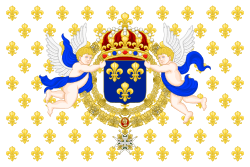Palais-Royal
The Palais-Royal (French pronunciation: [pa.lɛ ʁwa.jal]), originally called the Palais-Cardinal, is a former royal palace located in the 1st arrondissement of Paris, France. The screened entrance court faces the Place du Palais-Royal, opposite the Louvre. In 1830 the larger inner courtyard of the palace, the Cour d'Honneur, was enclosed to the north by what was probably the most famous of Paris's covered arcades, the Galerie d'Orléans. Demolished in the 1930s, its flanking rows of columns still stand between the Cour d'Honneur and the popular Palais-Royal Gardens.
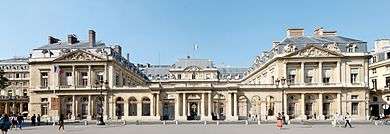
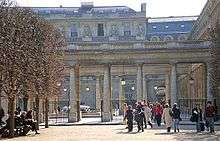
The Palais-Royal now serves as the seat of the Ministry of Culture, the Conseil d'État and the Constitutional Council.
History
Palais-Cardinal
_by_an_unknown_artist_(adjusted).jpg)
Originally called the Palais-Cardinal, the palace was the personal residence of Cardinal Richelieu.[1] The architect Jacques Lemercier began his design in 1629;[2] construction commenced in 1633 and was completed in 1639.[1] Upon Richelieu's death in 1642 the palace became the property of the King and acquired the new name Palais-Royal.[1]
After Louis XIII died the following year, it became the home of the Queen Mother Anne of Austria and her young sons Louis XIV and Philippe, duc d'Anjou,[3] along with her advisor Cardinal Mazarin.
From 1649, the palace was the residence of the exiled Henrietta Maria and Henrietta Anne Stuart, wife and daughter of the deposed King Charles I of England. The two had escaped England in the midst of the English Civil War and were sheltered by Henrietta Maria's nephew, King Louis XIV.
House of Orléans
Henrietta Anne was later married to Louis' younger brother, Philippe de France, duc d'Orléans in the palace chapel on 31 March 1661. The following year the new duchesse d'Orléans gave birth to a daughter, Marie Louise d'Orléans, inside the palace. After their marriage, the palace became the main residence of the House of Orléans.
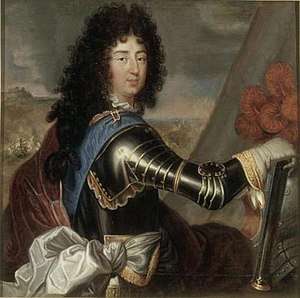
The Duchess created the ornamental gardens of the palace, which were said to be among the most beautiful in Paris. Under the new ducal couple, the Palais-Royal would become the social center of the capital.
The court gatherings at the Palais-Royal were famed all around the capital as well as all of France. It was at these parties that the crème de la crème of French society came to see and be seen. Guests included the main members of the royal family like the Queen Mother, Anne of Austria; the duchesse de Montpensier, the Princes de Condé and de Conti. Philippe's favourites were also frequent visitors.
The palace was redecorated and new apartments were created for the Duchess's maids and staff. Several of the women who later came to be favourites to King Louis XIV were from her household: Louise de La Vallière, who gave birth there to two sons of the king, in 1663 and 1665; Françoise-Athénaïs, marquise de Montespan, who supplanted Louise; and Angélique de Fontanges, who was in service to the second Duchess of Orléans.
After Henrietta Anne died in 1670 the Duke took a second wife, the Princess Palatine, who preferred to live in the Château de Saint-Cloud. Saint-Cloud thus became the main residence of her eldest son and the heir to the House of Orléans, Philippe Charles d'Orléans known as the duc de Chartres.[4]
Palais Brion
The House of Orléans did not occupy the northeast wing, where Anne of Austria had originally lived, but instead chose to reside in the palais Brion to the west of the main block, where the future regent, before his father died, commissioned Gilles-Marie Oppenord to decorate the grand appartement in the light and lively style Régence that foreshadowed the Rococo. These, and the Regent's more intimate petits appartements, as well as a gallery painted with Virgilian subjects by Coypel, were all demolished in 1784, for the installation of the Théâtre-Français, now the Comédie-Française.[5]
The palais Brion, a separate pavilion standing along rue Richelieu, to the west of the Palais-Royal, had been purchased by Louis XIV from the heirs of Cardinal Richelieu. Louis had it connected to the Palais-Royal. It was at the palais Brion that Louis had his mistress Louise de La Vallière stay while his affair with Madame de Montespan was still an official secret.
Later on, the royal collection of antiquities was installed at the palais Brion, under the care of the art critic and official court historian André Félibien, who had been appointed in 1673.
Françoise Marie de Bourbon, Duchess of Orléans
.jpg)
In 1692, on the occasion of the marriage of the duc de Chartres to Françoise Marie de Bourbon, Mademoiselle de Blois, a legitimised daughter of Louis XIV and Madame de Montespan, the King deeded the Palais-Royal to his brother.
For the convenience of the bride, new apartments were built and furnished in the wing facing east on the rue de Richelieu.[4] It was at this time that Philippe commissioned the gallery for his famous Orleans Collection of paintings, which was easily accessible to the public. The architect was Jules Hardouin-Mansart,[6] and the cost of this reconstruction was totaled to be 400,000 livres.[7] Hardouin-Mansart's assistant, François d'Orbay, prepared a general site plan, showing the Palais-Royal before these alterations were made. The garden shown on the plan was designed by André Lenôtre.
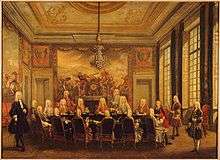
After the dismissal of Madame de Montespan and the arrival of her successor, Madame de Maintenon, who forbade any lavish entertainment at Versailles, the Palais-Royal was again a social highlight.[8]
When the Duke of Orléans died in 1701, his son became the head of the House of Orléans. The new Duke and Duchess of Orléans took up residence at the Palais-Royal. Two of their daughters, Charlotte Aglaé d'Orléans, later the Duchess of Modena, and Louise Diane d'Orléans, later the Princess of Conti, were born there.
La Régence and the reign of Louis XV
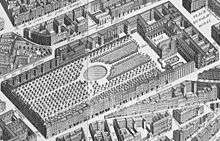
At the death of Louis XIV in 1715, his five-year-old great-grandson succeeded him. The Duke of Orléans became Regent for the young Louis XV, setting up the country's government at the Palais-Royal, while the young king lived at the nearby Tuileries Palace. The Palais-Royal housed the magnificent Orléans art collection of some 500 paintings, which was arranged for public viewing until it was sold abroad in 1791.
After the Regency, the social life of the palace became much more subdued. Louis XV moved the court back to Versailles and Paris was again ignored. The same happened with the Palais-Royal; Louis d'Orléans, who succeeded his father as the new Duke of Orléans, and his son Louis Philippe lived at the other family residence in Saint-Cloud, which had been empty since the death of the Princess Palatine in 1722.
The Palais-Royal was soon the scene of the notorious debaucheries of Louise Henriette de Bourbon who was married to Louis Philippe in 1743. New apartments (located in what is now the northern section of the Rue-de-Valois wing) were added for her in the early 1750s by the architect Pierre Contant d'Ivry.[9] She died at the age of thirty-two in 1759. She was the mother of Louis Philippe II d'Orléans, later known as Philippe Égalité.
The Palais under the stewardship of Louis Philippe II
A few years after the death of Louise Henriette, her husband secretly married his mistress, the witty marquise de Montesson, and the couple lived at the Château de Sainte-Assise where he died in 1785. Just before his death, he completed the sale of the Château de Saint-Cloud to Queen Marie Antoinette.
Louis Philippe II d'Orléans succeeded his father as the head of the House of Orléans. He was born at Saint-Cloud and later moved to the Palais-Royal and lived there with his wife, the wealthy Louise Marie Adélaïde de Bourbon whom he had married in 1769. The couple's eldest son, Louis-Philippe III d'Orléans, was born there in 1773.
Louis Philippe II, who controlled the Palais-Royal from 1780 onward, expanded and redesigned the complex of buildings and the gardens of the palace between 1781 and 1784. In 1780, he decided to commercialise the residence by letting out the area under the colonnades to retailers and service-providers and in 1784, the gardens and surrounding structures of the Palais-Royal opened to the public as a shopping and entertainment complex. Though the corps de logis remained the private Orléans seat, the arcades surrounding its public gardens had 145 boutiques, cafés, salons, hair salons, bookshops, museums, and countless refreshment kiosks. These retail outlets sold luxury goods such as fine jewelry, furs, paintings and furniture to the wealthy elite. Stores were fitted with long glass windows which allowed the emerging middle-classes to window shop and indulge in fantasies. Thus, the Palais-Royal became one of the first of the new style of shopping arcades and became a popular venue for the wealthy to congregate, socialise and enjoy their leisure time. The redesigned palace complex became one of the most important marketplaces in Paris. It was frequented by the aristocracy, the middle classes, and the lower orders. It had a reputation as being a site of sophisticated conversation (revolving around the salons, cafés, and bookshops)], shameless debauchery (it was a favorite haunt of local prostitutes), as well as a hotbed of Freemasonic activity. [10]
Shopping arcade
Over a decade or so, sections of the Palais were transformed into shopping arcades that became the centre of 18th-century Parisian social, economic and social life. [11] Inspired by the souks of Arabia, the Galerie de Bois, a series of wooden shops linking the ends of the Palais Royal, was first opened in 1786. [12] For Parisians, who lived in the virtual absence of pavements, the streets were dangerous and dirty; the arcade was a welcome addition to the streetscape as it afforded a safe place where Parisians could window shop and socialise. Thus, the Palais-Royal began what architectural historian Bertrand Lemoine describes as l’Ère des passages couverts (the Arcade Era), which transformed European shopping habits between 1786 and 1935.[13]
Designed to attract the genteel middle class, the Palais-Royal sold luxury goods at relatively high prices. However, prices were never a deterrent, as these new arcades came to be the place to shop and to be seen. Arcades offered shoppers the promise of an enclosed space away from the chaos that characterised the noisy, dirty streets; a warm, dry space away from the elements; and a safe-haven where people could socialise and spend their leisure time. Promenading in the arcades became a popular eighteenth century pastime for the emerging middle classes. [14]
%2C_au_Palais-Royal%2C_1825.jpg)
Within a decade, new arcades were opened at the Palais site, and it was transformed into a complex of gardens, shops and entertainment venues situated on the external perimeter of the grounds, under the original colonnades. The area boasted some 145 boutiques, cafés, salons, hair salons, bookshops, museums, and numerous refreshment kiosks as well as two theatres. The retail outlets specialised in luxury goods such as fine jewellery, furs, paintings and furniture designed to appeal to the wealthy elite. Retailers operating out of the Palais complex were among the first in Europe to adopt fixed prices and thereby spare their clients the hassle of bartering. Stores were fitted with long glass exterior windows (at the time shop glazing was virtually unknown in Paris), which allowed the emerging middle classes to window shop and indulge in fantasies, even when they may not have been able to afford the high retail prices. Thus, the Palais-Royal became one of the first examples of a new style of shopping arcade, frequented by both the aristocracy and the middle classes. By day the galleries, bookshops, salons, cafés, and restaurants were an important gathering place for the aristocracy, intellectuals, students and financiers. By night, it became the haunt of libertines, off-duty soldiers and prostitutes, many of whom rented apartments in the building.[15] In addition, charlatans, gambling houses, ventriloquists, pimps, and prostitutes held court on the doorstep of the royal palace. [16] Above all, it developed a reputation as being a site of sophisticated conversation, revolving around the salons, cafés, and bookshops, and the centre of Parisian social life. [17]
Theatres of the Palais-Royal
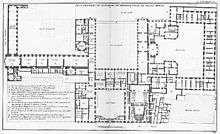
The Palais-Royal also contained one of the most important public theatres in Paris, in the east wing on the rue Saint-Honoré (on a site just to the west of what is now the rue de Valois).[18] It was built from 1637 to 1641 to designs by Lemercier and was initially known as the Great Hall of the Palais-Cardinal. This theatre was later used by the troupe of Molière beginning in 1660, by which time it had become known as the Théâtre du Palais-Royal. After Molière's death in 1673 the theatre was taken over by Jean-Baptiste Lully, who used it for his Académie Royale de Musique (the official name of the Paris Opera at that time).[19]
.jpg)
The Opera's theatre was destroyed by fire in 1763, but was rebuilt to the designs of architect Pierre-Louis Moreau Desproux on a site slightly further to the east (where the rue de Valois is located today) and reopened in 1770. This second theatre continued to be used by the Opera until 1781, when it was also destroyed by fire, but this time it was not rebuilt. Moreau Desproux also designed the adjacent surviving entrance facades of the Palais-Royal.[20]
At the request of Louis Philippe II, two new theatres were constructed in the Palais-Royal complex shortly thereafter. Both of these new theatres were designed by Victor Louis, the architect who also designed the garden galleries for the complex. The first theatre, which opened on 23 October 1784, was a small puppet theatre in the northwest corner of the gardens at the intersection of the Galerie de Montpensier and the Galerie de Beaujolais.[21] Initially it was known as the Théâtre des Beaujolais, then as the Théâtre Montansier, after which Victor Louis enlarged it for the performance of plays and operas. Later, beginning with the political turmoil of the Revolution, this theatre was known by a variety of other names. It was converted to a café with shows in 1812, but reopened as a theatre in 1831, when it acquired the name Théâtre du Palais-Royal, by which it is still known today.[22]
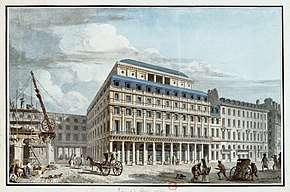
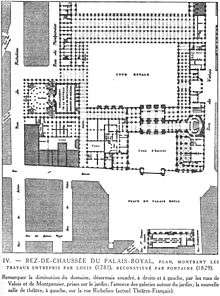
Louis Philippe II's second theatre was larger and located near the southwest corner of the complex, on the rue de Richelieu. He originally intended it for the Opera, but that company refused to move into it. Instead he offered it to the Théâtre des Variétés-Amusantes, formerly on the boulevard du Temple but since 1 January 1785 playing in a temporary theatre in the gardens of the Palais-Royal. This company changed its name to Théâtre du Palais-Royal on 15 December 1789, and later moved into the new theatre upon its completion, where they opened on 15 May 1790. On 25 April 1791 the anti-royalist faction of the Comédie-Française, led by Talma, left that company's theatre on the left bank (at that time known as the Théâtre de la Nation, but today as the Odéon), and joined the company on the rue de Richelieu, which promptly changed its name to Théâtre Français de la rue de Richelieu. With the founding of the French Republic in September 1792 the theatre's name was changed again, to Théâtre de la République. In 1799 the players of the split company reunited at the Palais-Royal, and the theatre officially became the Comédie-Française, also commonly known as the Théâtre-Français, names which it retains to this day.[23]
Palais de l'Égalité and the Revolution
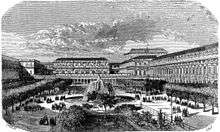
During the revolutionary period, Philippe d'Orléans became known as Philippe Égalité and ruled at the Palais de l'Égalité, as it was known during the more radical phase of the Revolution,[24] made himself popular in Paris when he opened the gardens of the palace to all Parisians and employed the neoclassical architect Victor Louis to rebuild the structures around the palace gardens, which had been the irregular backs of houses that faced the surrounding streets, and to enclose the gardens with regular colonnades that were lined with smart shops (in one of which Charlotte Corday bought the knife she used to stab Jean-Paul Marat).
Along the galeries, ladies of the night lingered, and smart gambling casinos were lodged in second-floor quarters. There was a theatre at each end of the galleries; the larger one has been the seat of the Comédie-Française, the state theatre company, since Napoleon laid its administrative reorganisation in the décret de Moscou on 15 October 1812, which contains 87 articles.[25] The very first theatre in the Palais-Royal was built by Lemercier for Cardinal Richelieu, and inaugurated in 1641. Under Louis XIV, the theater hosted plays by Molière, from 1660 to Molière's death in 1673, followed by the Opera under the direction of Jean-Baptiste Lully.
From the 1780s to 1837, the palace was once again the centre of Parisian political and social intrigue and the site of the most popular cafés. The historic restaurant "Le Grand Véfour" is still there. In 1786, a noon cannon was set up by a philosophical amateur, set on the prime meridian of Paris, in which the sun's noon rays, passing through a lens, lit the cannon's fuse. The noon cannon is still fired at the Palais-Royal, though most of the ladies for sale have disappeared, those who inspired the Abbé Delille's lines;
- "Dans ce jardin on ne rencontre
- Ni champs, ni prés, ni bois, ni fleurs.
- Et si l'on y dérègle ses mœurs,
- Au moins on y règle sa montre."
("In this garden one encounters neither fields nor meadows nor woods nor flowers. And, if one upsets one's morality, at least one may re-set one's watch.")
The Marquis de Sade referred to the grounds in front of the palace in his Philosophy in the Bedroom (1795) as a place where progressive pamphlets were sold.
Upon the death of the Duke, the palace's ownership lapsed to the state, whence it was called Palais du Tribunat.[24]
Bourbon restoration
After the Restoration of the Bourbons, at the Palais-Royal the young Alexandre Dumas obtained employment in the office of the powerful duc d'Orléans, who regained control of the Palace during the Restoration. In the Revolution of 1848, the Paris mob trashed and looted the Palais-Royal. Under the Second Empire the Palais-Royal was home to the cadet branch of the Bonaparte family, represented by Prince Napoleon, Napoleon III's cousin.
Today's Palais-Royal
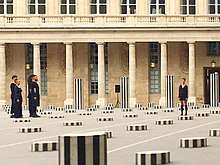
Today the Palais-Royal accommodates the Conseil d'État, the Constitutional Council, and the Ministry of Culture. At the rear of the garden, north of the Palais-Royal on the Rue de Richelieu are the older buildings of the Bibliothèque nationale de France.
The larger inner courtyard of the palace, the Cour d'Honneur, has since 1986 contained Daniel Buren's site-specific art piece Les Deux Plateaux, known as Les Colonnes de Buren.
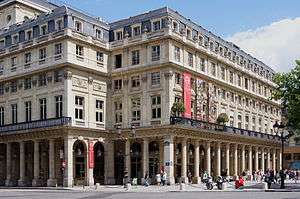
See also
References
Notes
- Horne, Alistair (2004). La Belle France. USA: Vintage. p. 131. ISBN 978-1-4000-3487-1. Retrieved 2010-12-07.
...between 1633 and 1639, Richelieu built a princely palace... which he bequeathed to the King. Known initially as the Palais-Cardinal, when the royal family moved in after Richelieu's death it gained the name it has held ever since, – Le Palais-Royal.
- Herbermann, Charles, ed. (1913). . Catholic Encyclopedia. New York: Robert Appleton Company.
He (Lemercier) began the Palais-Cardinal at Paris in 1629, which, after its donation to the king, was known as the Palais Royal.
- Parmele, Mary Platt (1906). A Short History of France. New York: C. Scribner's sons. pp. 142–143.
- Brother to the Sun king:Philippe, Duke of Orléans by Nancy Nicholas Barker
- "Le Palais-Royal des Orléans (1692-1793): Les travaux entrepris par le Régent". Archived from the original on July 7, 2007. Retrieved 2007-05-30.CS1 maint: BOT: original-url status unknown (link)
- Rudeck 2010.
- Nancy Nicholas Barker, Brother to the Sun King:Philippe, Duke of Orléans.
- The Sun King by The Hon. Nancy Freeman-Mitford
- Ayers 2004, p. 47.
- Byrne-Paquet, L., The Urge to Splurge: A Social History of Shopping, ECW Press, Toronto, Canada, pp 90-93
- Mitchell, I., Tradition and Innovation in English Retailing, 1700 to 1850, Routledge, Oxon, p. 140
- Conlin, J., Tales of Two Cities: Paris, London and the Birth of the Modern City, Atlantic Books, 2013, Chapter 2; Willsher, K., "Paris's Galeries de Bois, Prototype of the Modern Shopping Centre," [A history of cities in 50 buildings, day 6], 30 March, 2015
- Lemoine, B., Les Passages Couverts, Paris: Délégation à l'action artistique de la ville de Paris [AAVP], 1990. ISBN 9782905118219.
- Byrne-Paquet, L., The Urge to Splurge: A Social History of Shopping, ECW Press, Toronto, Canada, pp. 90–93; Mitchell, I., Tradition and Innovation in English Retailing, 1700 to 1850, Routledge, Oxon, p. 140
- Byrne-Paquet, L., The Urge to Splurge: A Social History of Shopping, ECW Press, Toronto, Canada, pp. 90–93
- Conlin, J., Tales of Two Cities: Paris, London and the Birth of the Modern City, Atlantic Books, 2013, Chapter 2; Willsher, K., "Paris's Galeries de Bois, Prototype of the Modern Shopping Centre," [A history of cities in 50 buildings, day 6], 30 March, 2015
- Byrne-Paquet, L., The Urge to Splurge: A Social History of Shopping, ECW Press, Toronto, Canada, pp. 90–93
- Ayers 2004, pp. 47–48.
- Clark 1998, pp. 1–2, 19–20.
- Pitou 1983, vol. 1, pp. 13, 26–30; Ayers 2004, pp. 47–48.
- Hemmings 1994, p. 37; Wild 2003; for the opening date see the entry "Beaujolais (théâtre des)" in Lecomte 1905, p. 15.
- Wild 2003; Ayers 2004, pp. 47–48; see also the first entry for "Variétés (théâtre des)" in Lecomte 1905, p. 55, and the entry "Palais-Royal (2e théâtre du)" on p 47.
- Netter 1996, pp. 69–70; Hemmings 1994, pp. 60–63; see also the entry "Variétés-Amusantes" in Lecomte 1905, p. 55, and the entry "Français de la rue Richelieu" on p. 29..
- Segard; Testard (1814). Picturesque Views of Public Edifices in Paris, p. 9. London: Gale, Curtis, and Fenner. View at Google Books.
- Bouchard, Alfred (1878). La langue théâtrale: vocabulaire historique, descriptif et anecdotique des termes et des choses du théâtre, p. 83 (in French). Paris: Arnaud et Labat. View at Google Books.
- Typhenn Le Guyader, "Invitation aux recontres dans La Figure du Baiser de Nathalie Pernette", ResMusica, 19 May 2017.
Sources
- Ayers, Andrew (2004). The Architecture of Paris. Stuttgart: Axel Menges. ISBN 9783930698967.
- Clarke, Jan (1998). The Guénégaud Theatre in Paris (1673–1680). Volume One: Founding, Design and Production. Lewiston, New York: The Edwin Mellen Press. ISBN 9780773483927.
- Fauquet, Joël-Marie, editor (2001). Dictionnaire de la musique en France au XIXe siècle. Paris: Fayard. ISBN 9782213593166.
- Hemmings, F. W. J. (1994). Theatre and State in France, 1760–1905. New York: Cambridge University Press. ISBN 978-0-511-00042-3. ISBN 978-0-521-03472-2 (2006 paperback reprint).
- Kennedy, Emmet; Netter, Marie-Laurence; McGregor, James P.; Olsen, Mark V. (1996). Theatre, Opera, and Audiences in Revolutionary Paris. Westport, Connecticut: Greenwood Press. ISBN 978-0-313-28960-6.
- Lecomte, Louis-Henry (1905). Histoire des théâtres 1402–1904. Notice préliminaire. Paris: Daragon. View at Google Books.
- Netter, Marie-Laurence (1996). "Theatres and Their Directors" in Kennedy et al. 1996, pp. 65–73.
- Pitou, Spire (1983–1990). The Paris Opéra: An Encyclopedia of Operas, Ballets, Composers, and Performers (3 volumes). Westport, Connecticut: Greenwood Press. ISBN 978-0-686-46036-7.
- Rudeck, Claudia (2010). "Aile de la galerie du Palais-Royal", pp. 417–420, in Jules Hardouin-Mansart 1646–1708, edited by Alexandre Gady. Paris: Éditions de la Maison des sciences de l'homme. ISBN 9782735111879.
- Wild, Nicole (2003). "Palais-Royal, Théâtre du" in Fauquet 2003, p. 932.
External links
| Wikimedia Commons has media related to Palais Royal. |
- Satellite image from Google Maps
- Palais Royal – Louvre district - current photographs and of the years 1900
- Virtual Paris - Photos of Palais-Royal and VR views
- Panoramic View of Palais Royal @ Places of Interest
